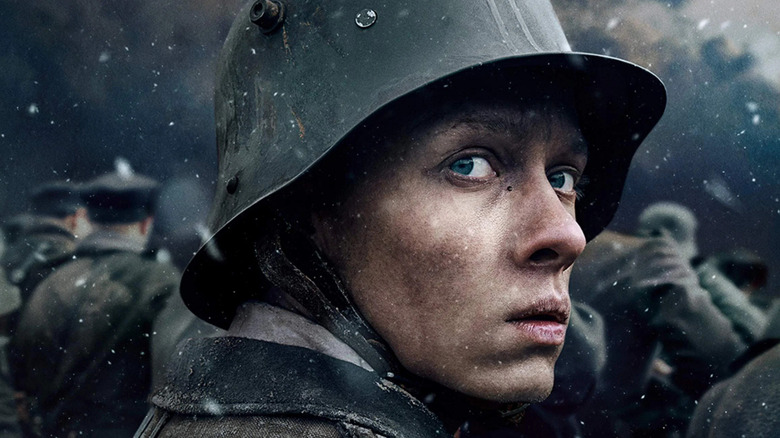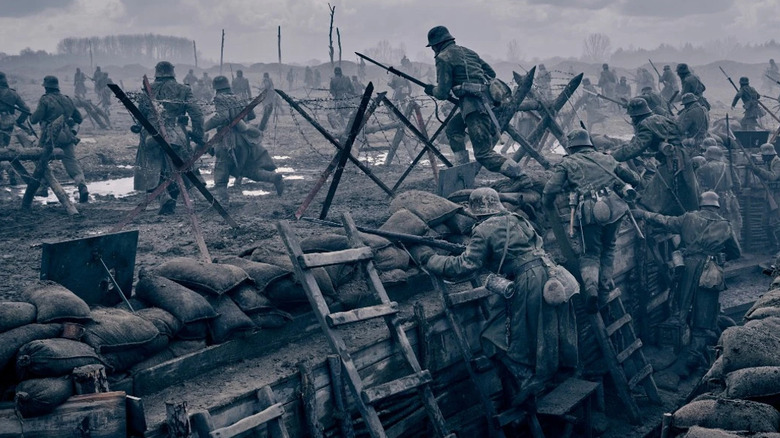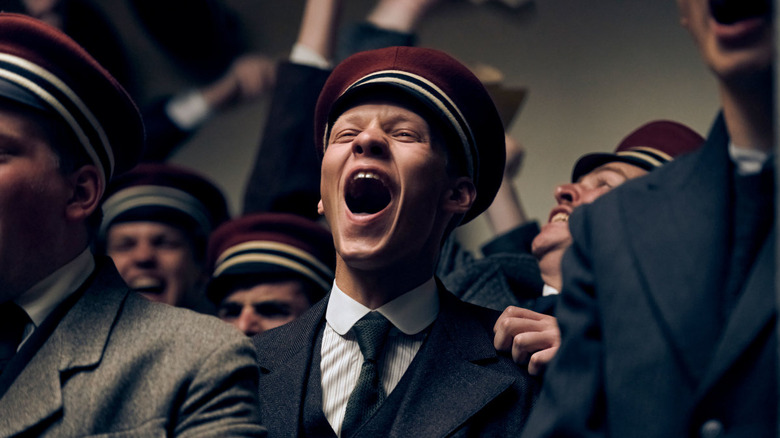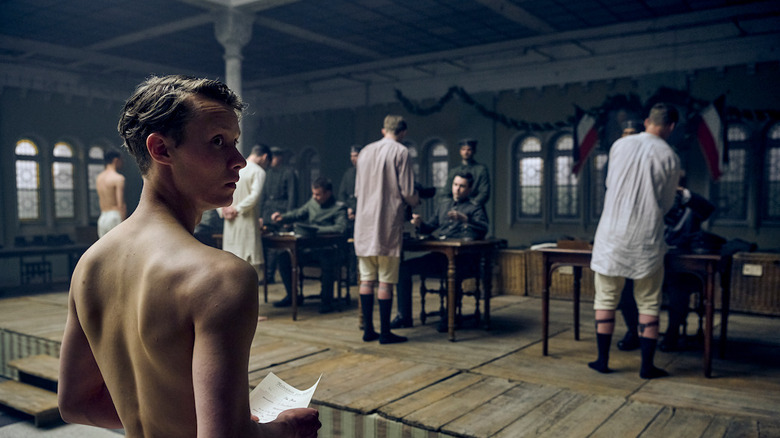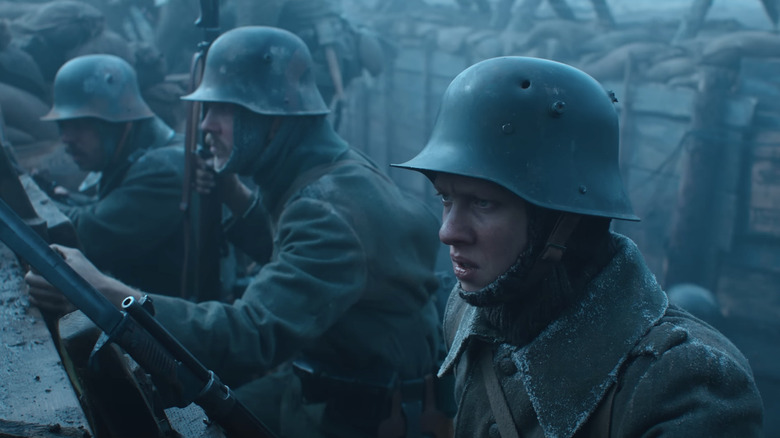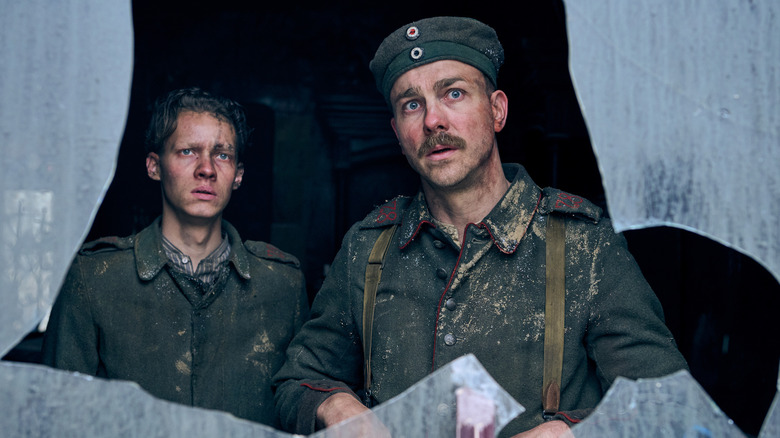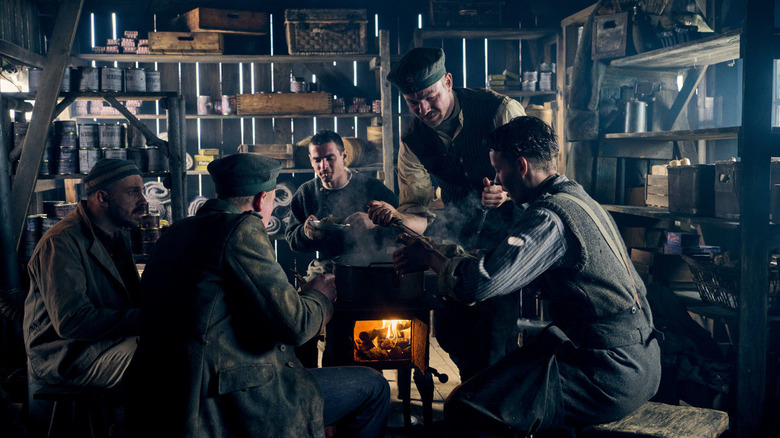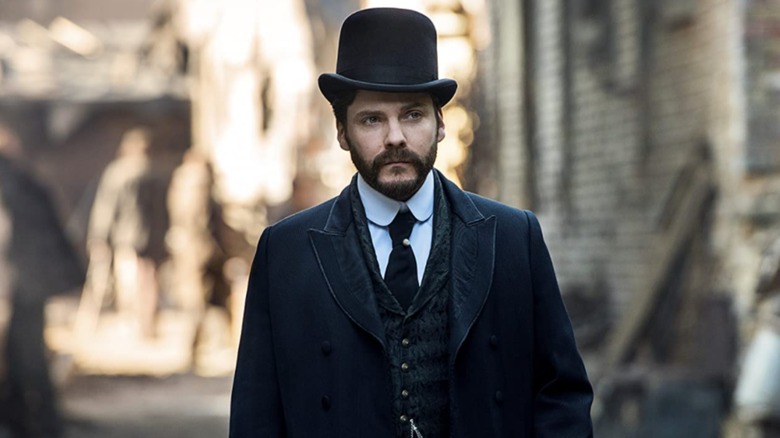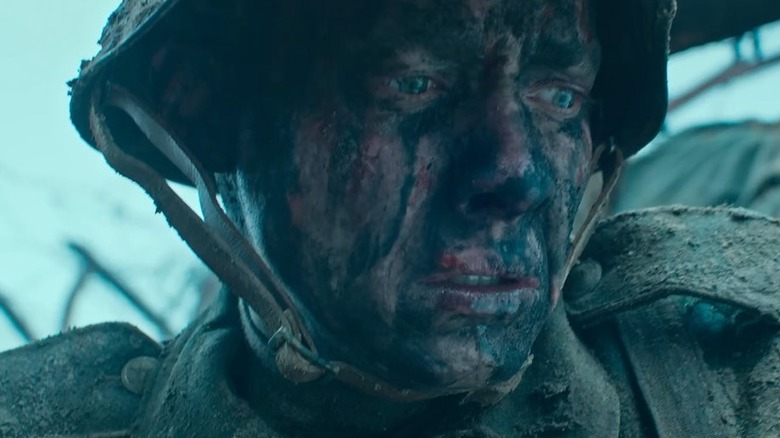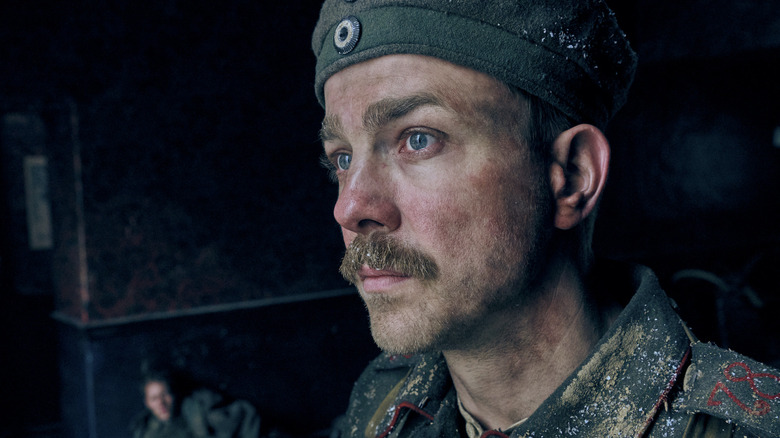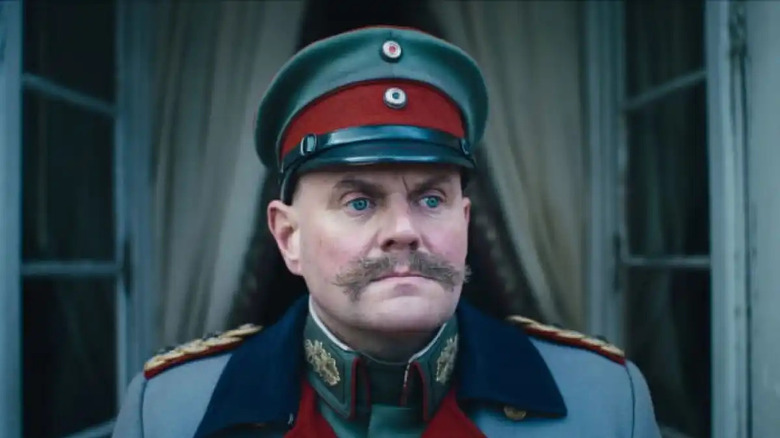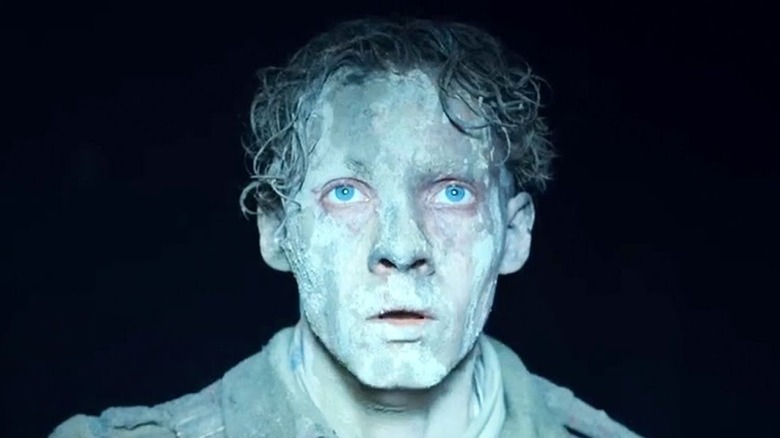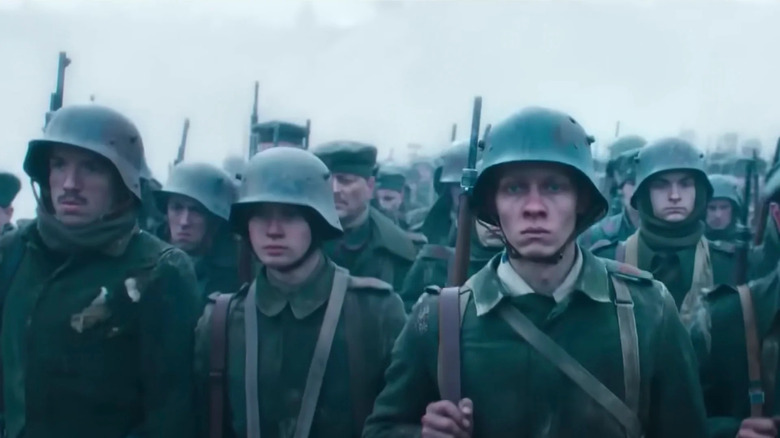The Ending Of All Quiet On The Western Front Explained
Contains spoilers for "All Quiet on the Western Front."
2022's "All Quiet on the Western Front" is the third filmed adaptation of Erich Maria Remarque's best-selling 1929 anti-war novel of the same name. This version, rolling out in theaters before a Netflix October 28th, is co-written and directed by Edward Berger. The World War I drama has already been chosen as Germany's submission for best international feature at next year's Academy Awards (via Deadline), and is gaining such critical acclaim that it debuted with a perfect score on Rotten Tomatoes, which all speaks highly of the film. The performances are gripping, the cinematography and score are hauntingly dramatic, and the action is some of the most epic and difficult-to-stomach to be found in any war movie.
Still, this "All Quiet on the Western Front" has big shoes to fill. An adaptation released just a year after the book was published went on to win Best Picture at the 1930 Oscars. A remake from 1979 won an Emmy for Best Motion Picture Made for Television. And the novel itself — which was banned by Nazis because of its themes (per The University of Utah) — remains an esteemed and widely read literary classic to this day, particularly for its accurate descriptions of trench warfare and its unromantic and critical view of war itself (its author was a veteran of the conflict). Like its source material, this latest update can be challenging. It's long, subtitled, and punishing, but it rewards the viewer in the end. Read on to understand how this latest update builds on the iterations that came before it, and what to make of that darkly poetic ending.
The character we think is the protagonist dies early
To fully appreciate that heart-wrenching ending, we must return to the disorienting prologue, which is an invention of Berger's film. "All Quiet on the Western Front" opens with sequence in which a young German soldier named Heinrich is in the midst of an escalating battle. He witnesses plenty of boys of his age and skill level getting mowed down by gunfire all around him. The camera stays with Heinrich as he tries to decide whether to gather the courage to fight or give in to his fear and freeze. His superiors scream at him to join the fray, but it slowly dawns on Heinrich and the audience that the Germans have the worst of it in this particular skirmish. Still, we're fooled into thinking that, because the film is treating Heinrich like its protagonist, it might provide him with enough plot armor to make it across No Man's Land.
Seconds later, however, when the enemy (from the Germans' perspective) comes charging across the muddy field in much greater numbers, it hits us and Heinrich all at once that he's going to die. He decides to go out fighting and engages his combatants with a shovel. One hard cut later, we see the boy's body lying in a pile of other bodies which had belonged to characters whose names we never got to know. In a montage that's ostensibly about work and process but is really about the senseless human cost of war, those bodies are stripped of their tattered, soiled uniforms. Those uniforms are scrubbed and wrung clean, mended, and readied for the next boys who will fill them.
Paul joins the war effort
We meet our true protagonist, Paul Bäumer, at school shortly thereafter. He's a fresh-faced and bright-eyed student of 17 who forges his parents' signature on a piece of paper against his friend's back as mindlessly as if he's faking a permission slip for a field trip. But he, his three best friends, and a stairwell full of his classmates are gleefully signing up for the Great War. They're so gleeful because their headmaster, Kantorek, has pumped them up with a propagandist speech about valor and glory that preys upon the boys' need for identity, purpose, and the trappings of what they consider to be maturity and manhood.
This version of "All Quiet on the Western Front" makes use of a famed line from the book (just barely edited for the screen) by way of a brief title card. "This is neither an accusation nor a confession, and least of all an adventure. For death is not an adventure to those who stand face to face with it." But at this point in the story, Paul and his brothers-in-arms behave entirely as if they're embarking on an adventure, and death appears to be the furthest thing from their minds. We'll learn later on that Paul joined the war effort either against his parents' wishes or without them knowing because he wanted to prove himself to his family and his community. Only at the very end of the movie does Paul realize how misguided this motivation was.
Paul gets Heinrich's uniform
If Paul is nervous at all early on, it's only because he hopes the powers that be will accept his enrollment form so that he can follow his friends into military service. He and the other new recruits are given their gear as if they're Boy Scouts about to go on a camping trip. Paul notices that there's still a name tag sewn into his coat. He says there's been a mistake; this uniform already belongs to someone. The enlisted man behind the desk rips off the tag and makes up an excuse: it didn't fit that soldier.
Of course, we know that the uniform in question belonged to Heinrich, who was killed wearing it. The boys likely expected that their clothes, weapons, and provisions were all new, but they're only new to them. Paul notices the patch that's fixed the bullet hole in Heinrich's jacket. The reuse of the uniforms and equipment is meant to make it obvious how the filmmakers (and before them, Remarque) feel about war. That the helmets, coats, boots, and rifles survive cycle after cycle of the violence while the men do not drives home the point that these teenage boys are more disposable than things made of cotton, metal, and wood. Though movie conventions condition us to assume the point-of-view character will survive (as is the case in nearly-as-brutal "1917"), even those who haven't read the text might guess Paul's fate based on the uniform he's issued.
Paul's attitude changes once the fighting starts
The boys get their first glimpse of the horrors of war when their transport is stopped and commandeered to help evacuate the dead and wounded. They have to walk the rest of the way, which is an unpleasant challenge. Still, morale is relatively high as they sing somewhat silly battle anthems to the beat of their march steps. Even as they affix gas masks and take their positions in the trenches, the mood is one of excitement and anticipation ... until the enemy can be heard advancing and shells begin to explode. Paul, his friends, and a few more experienced soldiers (including Stanislaus "Kat" Katczinsky) scramble to find cover. The truth of their situation sets in. Some of them want to go home. One infantryman tries to flee and is incinerated by a blast before he can make it out of sight. Then the shelter collapses in on them, killing several men.
Paul is trapped underneath the rubble, winded but otherwise unharmed. He's rescued, given a bite of food and a few seconds to come to, then he's tasked with collecting the dog tags of the fallen soldiers (they're a symbol that will reappear twice more in the film). As he breaks apart the metal disc that contains each young man's name and hometown, he and the audience are taking a literal toll of the cost of war. Among the lifeless, mutilated bodies, he finds the friend to whom the glasses belonged. Paul and his remaining comrades, Alfred and Frantz, are permanently changed by the experience of their first battle, but they have no choice but to go on.
Kat becomes his mentor
Along with Paul and his friends, Stanislaus Katczinsky is one character who appears in the original novel as well as the other two filmed adaptations. At first, Kat and the older infantrymen are annoyed when new recruits join their ranks, and for good reason. These green schoolboys who don't yet know their way around the trenches are a liability, and they know they'll probably have to watch most of them die. But as Paul persists, Kat takes him under his wing. He keeps him as calm and focused as is possible during active engagement with the Allies, and he keeps things as light and normal as possible during the long, empty, and bleak stretches of time in between the horrors of the battlefield.
In part, Kat and Paul bond because Kat receives letters from his wife at home, though he's illiterate. Paul reads the letters — which contain deeply personal details, including references to the death of their child — aloud to Kat. He also accompanies his new mentor on ill-conceived missions to steal livestock and eggs from a nearby French farmer when their food runs low. It's important to note that, in peacetime, Kat would rank below Paul. He's an uneducated cobbler while well-educated Paul belongs to the middle class and will be destined for bigger things, should he make it through the war. But on the ground in 1917, Kat's age, time served, and bravery in battle make him Paul's superior. Paul survives as long as he does in no small part thanks to Kat's guidance.
The top brass and the infantry experience war differently
Another effective addition to this rendering of "All Quiet on the Western Front" is the perspective of the diplomats and generals who are pulling the strings far away from the front lines. Paul, Kat, and company's daily life is unrecognizable to their lives before the war. Even when they aren't under direct threat, they're living out in the elements, relieving themselves in open ditches, going weeks or months without bathing or cleaning their clothes, and happy to have any morsel of sustenance they can scrounge. Their injuries fester. Their mental states deteriorate as steadily and surely as the soles of their muck-laden boots. And every one of them knows they could fall victim to gunshots, gas, grenades, or any other number of dangers at any given moment.
But for characters like General Friedrich and Generalmajor von Winterfeldt, life has barely changed at all. Their pristine, pressed uniforms look as presentable as ever. They continue to sip tea from fine china cups and saucers and dine on multi-course meals, seated upon comfortable upholstered chairs at white clothed tables, served just as if they're back home in their estates. They're warm, clean, full-bellied, and most consequentially, they're safe in their train cars and upstairs offices. These scenes contrast how theoretical the exercise of war is for those calling the shots with how visceral it is for those taking them. They appear in the 2022 adaptation in place of a scene in which Paul is temporarily given leave to go home. In previous versions, it's Paul's hometown that's unaware of the realities of trench warfare and indifferent to the soldiers' suffering.
Ezberger wants to negotiate peace
One of the nicely dressed diplomats in those train cars is Daniel Brühl, who has a small but significant supporting role as Matthias Erzberger, a real life figure who actually did sign the Armistice between Germany the Allies (via Britannica). Erzberger was a centrist who came to oppose the war and worked behind the scenes to bring the fighting to an end. As is portrayed so deftly in the movie, negotiating peace has to be handled tactfully because the German military doesn't want to appear to make concessions, let alone admit defeat. But the Central Powers (Germany, Austria-Hungary, the Ottoman Empire, and Bulgaria) are in disarray, and with the end of the war all but a foregone conclusion to the rational adults in the room, entertaining the terms of a treaty isn't going to be a matter of if but when.
Using massive amounts of those dog tags we saw earlier, Erzberger has one of his men record an account of just how many losses the Germans are racking up (it's hundreds of thousands) in the hope that it'll sway the politicians and military commanders to agree to ceasefire sooner rather than later. The French are more than happy to stop the bloodshed, so long as the Germans sign the treaty exactly as is. But Germany, despite its idea of its Kaiser and itself as unquestionably superior, has devolved into several factions, and Erzberger represents only one. His objective is to convince the more hawkish players to get on board with his plan before France's 72 hour deadline expires and countless more young men die.
Paul grapples with death, face to face
In both the book and the movie, few place names or specific dates are mentioned. That's on purpose; the author and the filmmakers want to immerse the reader and viewer in the anonymous slog of war. "All Quiet on the Western Front" isn't meant to commemorate any particular moment of heroism. In the climactic penultimate battle, Paul and Kat escape death multiple times, from bombs, tanks, bayonets, and flamethrowers. Their friend Albert isn't so lucky, burned alive before their eyes.
Paul and Kat are separated from each other when Paul frantically trips into a swampy basin to hide out and perhaps snipe at the enemy from a distance. Instead, he finds himself in close contact with a French soldier who intends to kill him. They square off in hand-to-hand combat until Paul makes his move and stabs the man near his neck.
He thinks he's delivered a quick but necessary death, but the Frenchman gags blood and pleads for his life for several grueling minutes. An emotional Paul is at war with himself. He switches from trying to end the man's life to trying to save it, or at least to comfort him as he takes his final breaths. He sobs and apologizes profusely as the wounded Frenchman succumbs to his injuries. Paul searches his jacket for proof of who he was and discovers that he had a name and a family. He promises the corpse that he will do right by them, but loses the wallet as the war continues. This scene is here to force Paul and the audience to confront what it means to take a life, which is rarely so underscored in stories about war.
Paul's friends die
Word of a potential ceasefire is beginning to spread around camp, but the specter of death still looms in makeshift hospitals and in the subconsciousness of the legions of broken men. Franz's leg is destroyed. They bring him soup to cheer him up, but even if he survives his wounds (which is far from certain) the thought of living out the rest of his days as a paralytic is too much for him. Or maybe it was all too much, the mental and the physical toll. Instead of being fed the soup, he stabs himself in the neck and dies on his own terms.
Shortly after, Kat and Paul find themselves back near the farm from which they stole poultry earlier. As if to celebrate the just-announced Armistice, they sneak into the coop with roles reversed this time. Paul collects eggs while Kat stands guard. Again, he and Kat narrowly escape the farmer's rifle, but just as the two friends are catching their breath and laughing about what life will be like when they're reunited with their families, the farm boy tracks down Kat in the woods and fires one shot. Believing he can be saved if they can make it back to base, Paul carries him to infirmary, where a doctor breaks the news that Kat's already dead of blood poisoning. In the book, Kat's hurt in a blast. Paul helps him back only to learn that a piece of shrapnel has lodged in his head and killed him. In both cases, Kat's death is the final blow to Paul's morale.
General Friedrich wages one more battle
The news of Erzberger's negotiated peace is made official. At precisely 11:00 in the morning on the 11th day of the 11th month, hostilities will come to an end and the war will be over. The infantrymen feel relief, but they're so beaten down by the last four years that there's little to rejoice about. Still, for the men on the ground, that relief greatly outweighs how painfully felt is the notion that Germany has lost. That's not so for the generals, however, and it's especially not the case for General Friedrich, who does the math and realizes there's time left for one more assault on the French line. Standing at his balcony, with operatic music blaring, he compels the men below to fight and perhaps to die for him as the clock winds down.
Paul and his comrades know their sacrifice will be for nothing, but they also know there's no disobeying this order. The General is already plotting where his career will go from here, and in a larger sense, where Germany will go from here. We're meant to take away from his last angry stand that this is the type of nationalist fanatic who will give rise to the Third Reich. The soldiers, who are mere minutes from salvation, are a mix of terrified last-minute recruits (like the young man who buddies up to Paul), and beleaguered veterans, like Paul, who are beyond caring whether they live or die. The combination of the pompous hate in the General's eyes, the quaking fear in the new recruits' faces, and the numbness in the faces of men like Paul make for an existentially devastating final battle.
Paul is killed at the exact moment the war ends
Inherent in that devastation is not only the idea that more men and boys are dying for nothing, but that these already dehumanized soldiers are being asked to take life for no reason. It's bad enough that they were carted away from their hometowns and families and asked to kill in the name of the Kaiser, God, and country (in that order), when they at least believed that stated purpose to be true. But now, they're being commanded to kill or be killed solely because of the General's pride and appetite for such violence.
Paul does what he's told. He invades the French fox holes. He kills who he can and defends himself from the French soldiers who are trying to kill him. But there's a listlessness to his movement and his expression. He's not as bothered by the taking of a life as he was in the crater, nor is he as desperate to survive as he has been the whole movie. Paul tries to protect the new recruit but falls down some stairs into a dark room. There, he finds himself in a skirmish with a Frenchman who seems shocked that Germany is attacking after the treaty has been signed. An unseen third person stabs Paul in the back through the chest. He emerges from the shadowy stairwell covered in white ash with red blood trickling from a hole near his heart. In the distance, he hears the horns signaling the official end of the Great War, and he sits down to consider his part in it and die.
The new recruit collects dog tags
The young boy who ran into battle next to Paul survives General Friedrich's reprehensible literal last-ditch effort. Like Paul was after he first saw active duty, the boy is shaken but otherwise fine. A higher-up orders him to collect dog tags, which he does, just as Paul had done a year or two ago. This slightly new take on the book's ending illustrates how mechanical and indifferent to the value of human life war is. In the original, Paul dies reaching out to touch a butterfly near the end of the war. His death here is even more tragic and symbolic.
That the movie closes on the discovery of Paul's serene dead body brings the theme full circle. Heinrich was slaughtered and was replaced by Paul. Paul was slaughtered and was replaced by an even younger soldier, who is every bit as innocent and loved by his family as Paul had been. Paul replaced Kat as a role model and friend to this very boy who bends down to look for proof of his identity. He recognizes his face from the short time they spent together, then neatens the scarf around his neck, which Franz had taken as a souvenir from the French girls. This seemingly banal act is an acknowledgement of Paul's humanity — a humanity that was lost long before Paul's death. It was shocking in 1929 (just as it is in 2022) that Remarque's protagonist doesn't make it out of his own story alive, but that's the point. "All Quiet on the Western Front" isn't primarily a political or historical document; it's a sensory overload statement that war is destruction.
